The Surface 3 Review
by Brett Howse on May 4, 2015 9:00 AM ESTGPU Performance
The Surface 3 with the Atom x7-Z8700 pairs the Intel Gen 8 Graphics from Broadwell with the Airmont CPU cores of Atom. Unlike the Broadwell cores though, the Surface 3 SoC only has 16 execution units (EUs) as compared to 24 in Core M. The maximum frequency is also reduced to 600 MHz for these cores, as compared to up to 900 MHz in Core M. This is all necessary to keep the x7-8700 in the 2 watt SDP.
So performance will be a step back compared to Core M, but really this should be no surprise. The interesting comparison will be how it compares to Surface Pro 3 with Haswell Gen 7.5 graphics and of course to Bay Trail equipped tablets.
We will start with some synthetic tests and then move on to DOTA 2 to see how it performs on a real world game.
3DMark Tablet
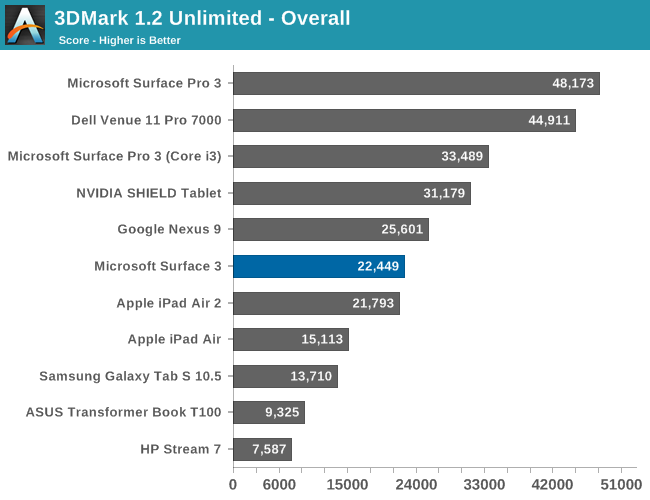
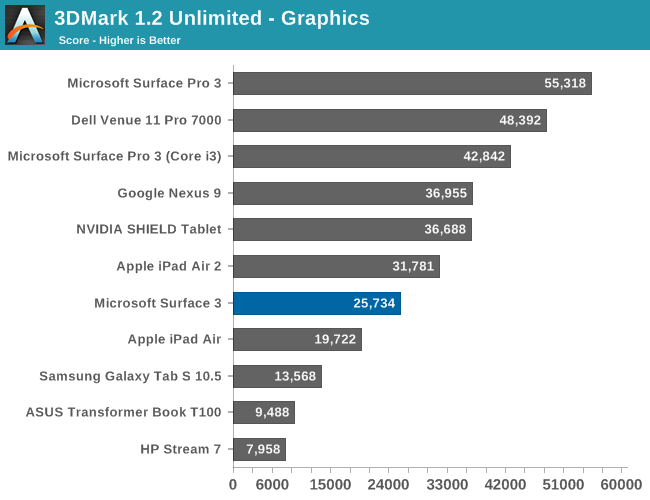
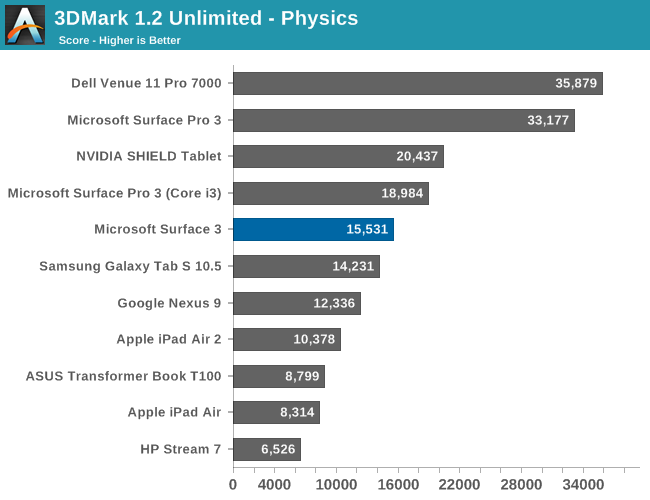
The GPU upgrade is a big improvement over the ASUS T100's Bay Trail graphics, but the Atom GPU still can not compete with the fastest tablet SoCs out there.
3DMark Notebook
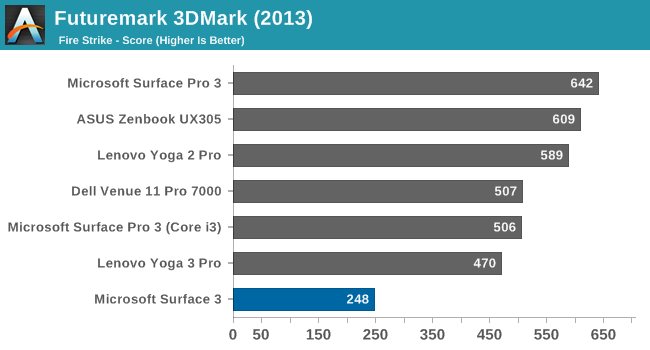
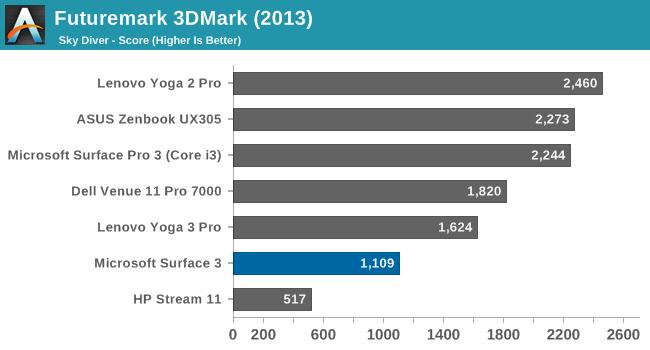
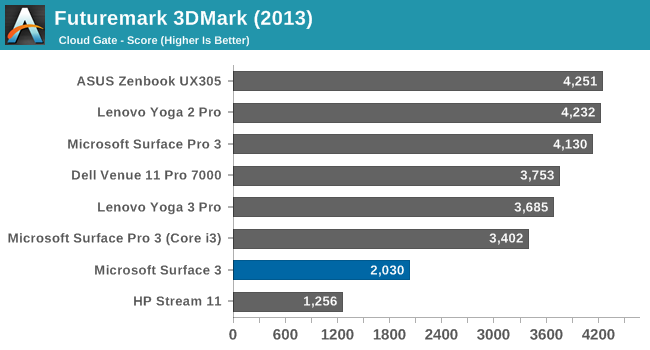
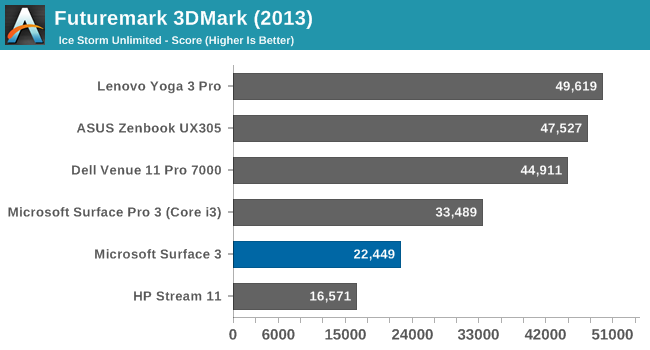
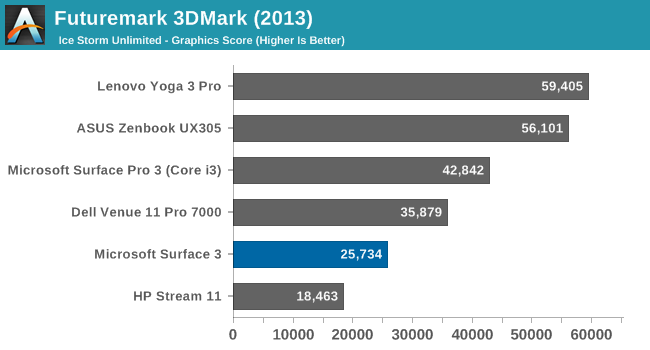
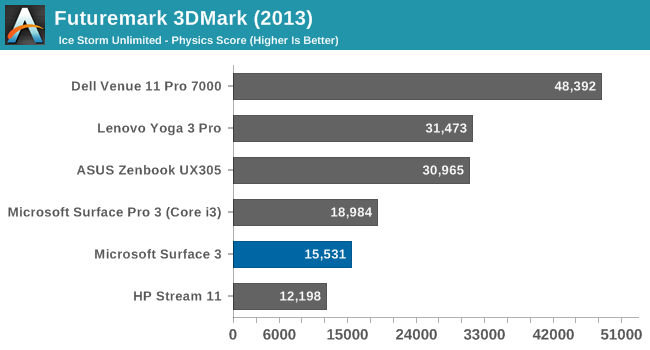
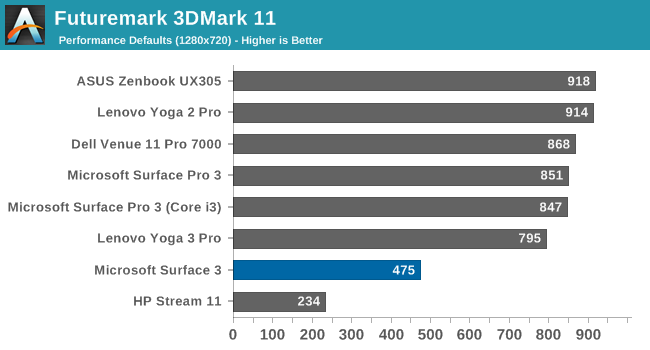
Comparing the Surface 3 to PC class hardware puts it in a pretty poor light when looking at GPU performance. Our 3DMark tests have the Surface Pro 3 with the Core i3 on average 40% faster than Surface 3. Comparing it to the Dell Venue 11 Pro with Core M, we find the Core M GPU is on average 47% faster, which is quite a gap. Let’s not forget though that the Surface 3 is a mere 2 watt SDP, whereas Core M is a 4.5 W TDP and the Haswell-Y in Surface Pro 3 is an 11.5 W TDP.
GFXBench Tablet (OpenGL)
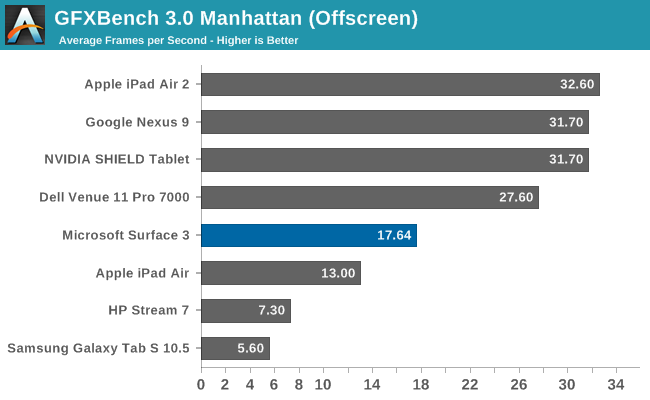
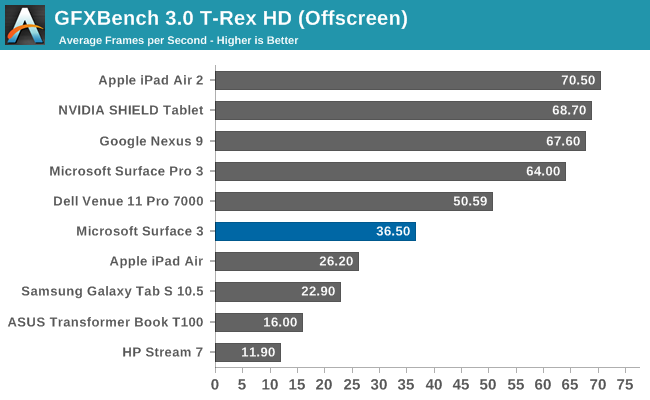
As with the 3DMark scores, the GPU upgrade is significant, but still a ways back of the best tablet GPUs out there. Intel still has some work to do on this front.
GFXBench Notebook (DirectX)
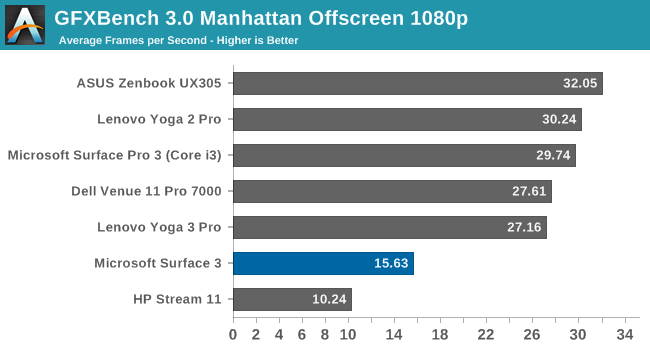
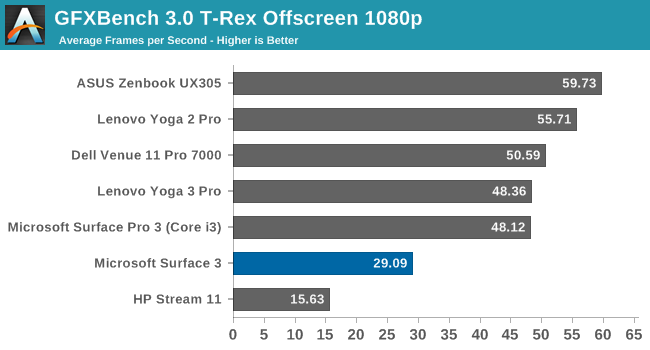
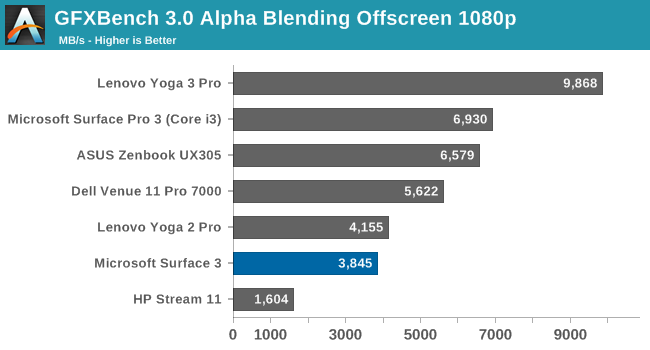
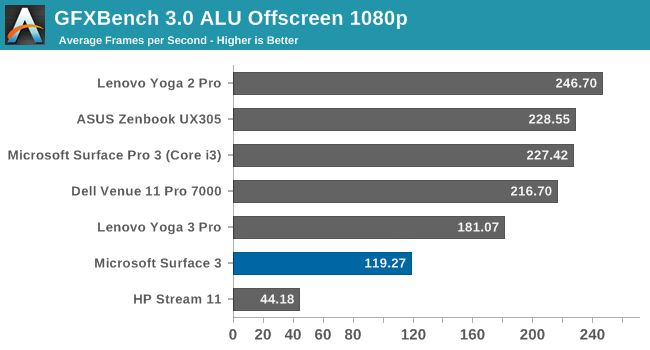
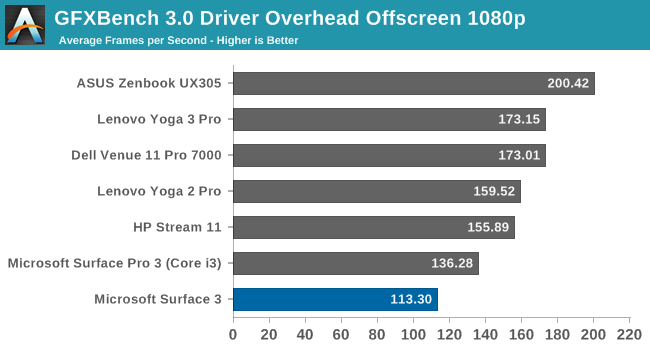
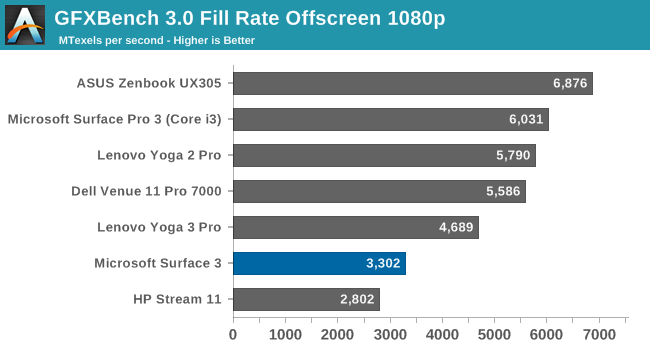
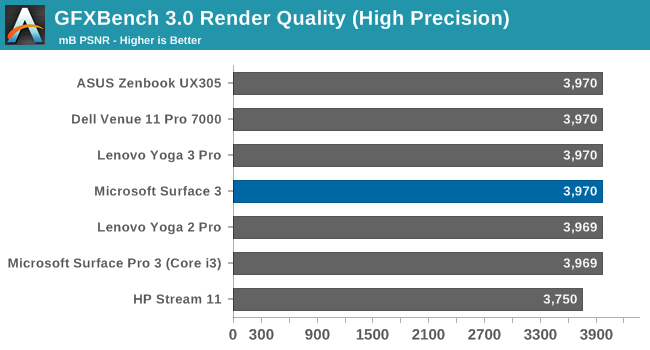
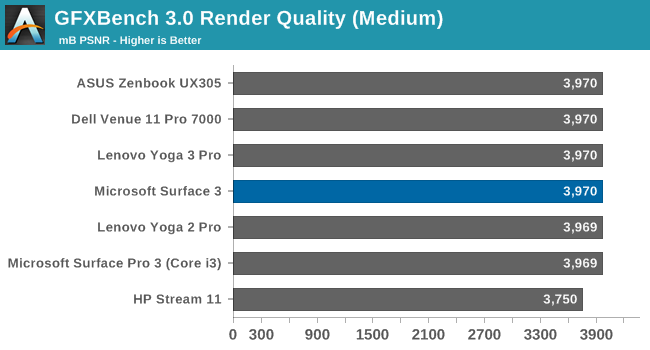
We see a similar story with GFXBench on the notebook side. The 16 EUs in our Atom SoC just cannot compete against the larger and faster GPUs in Core.
Moving on to a real-world game, we use a custom DOTA 2 benchmark for our lower powered devices. It is a very popular battle-arena game, and the GPU requirements are not too demanding.
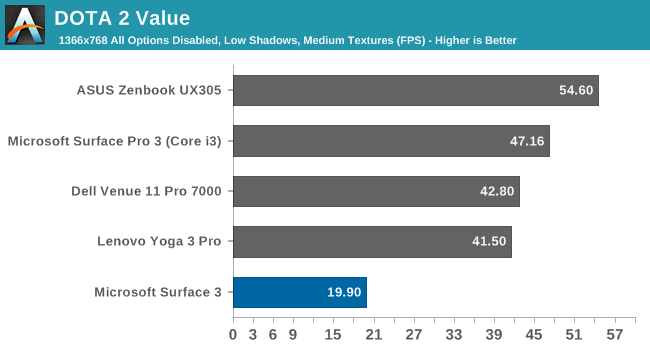
The GPU in the Surface 3 is really not enough to play most games, and even on our value settings, the Surface 3 is not a great experience for DOTA 2. The higher TDP of Core M lets it do ok in this test, but overall the Surface 3 is a long way back of even the Surface Pro 3 Core i3.
Storage Performance
Like most tablets, the Surface 3 utilizes eMMC storage rather than the SSD storage found on higher priced laptops and Core M tablets. It costs less, it is less complex, and it works. So expectations are that it will not be able to compete with the fastest solutions out there. But as a tablet, workloads should be less complex, at least in theory.
Unfortunately Microsoft shipped me the 64 GB version of the tablet, and due to PCMark 8 requiring a large amount of free space in order to perform its tests, it was unable to be run on this device. But we have run into this issue in the past, and we can turn to a couple of other tools to get a feel for how the storage performance is. Even though eMMC is slower than a good SSD, there is still different levels of performance based on the NAND in use and the controller.
I ran CrystalDiskMark over a 4 GB span and the results are below.
Surface 3 eMMC Storage (left) vs Surface Pro 3 Core i3 SSD (right)
Compared to a true SSD, the eMMC performance leaves a lot to be desired. In fact, most of the time when I was using the tablet and I found it slow, such as installing software, or loading programs, it was mostly disk bound. There are faster eMMC options available, but I will refrain from comparing it to other tablets since we do not have the same benchmarking tools for both.


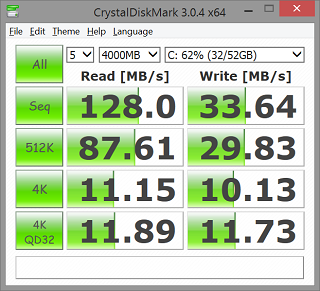
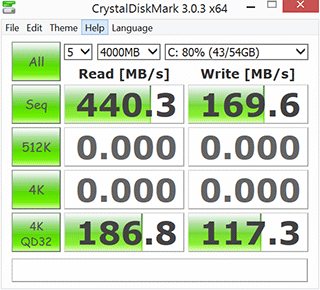








265 Comments
View All Comments
meacupla - Tuesday, May 5, 2015 - link
Proprietary connectors only suck when they are easy to break and hard to replace.That said, micro USB connectors also suck on these devices, because they're also easy to break and hard to replace.
The magnetic reverseable connector on previous surface devices was perfectly fine. They were hard to break and easy to replace. Basically, the side that broke most often was either the cable or brick, which is much cheaper to fix or replace compared to the device itself.
ddawg609 - Monday, May 4, 2015 - link
Will it upgrade to Windows10 when it is released?BlueBomberTurbo - Monday, May 4, 2015 - link
Yup, everything that uses Windows 7 through 8.1 can be upgraded to Windows 10 for free for the first year of release.mva5580 - Monday, May 4, 2015 - link
As it seems with most devices these days, my main concern is with battery life.What I really want it to be is an iPad replacement that also happens to be a full PC. I'm fine with the price point (an 128gb iPad Air 2 without a case/keyboard is $700,) I'm fine with the performance (I will play games on it, but stuff that it can handle. SimCity 3000, Baldurs Gate, Out of the Park Baseball, stuff like that,) and the form factor is small enough to feel like a tablet but big enough to be able to do most "full" PC things on it.
It just seems like whenever I look at devices anymore, I'm disappointed in the battery life. So I guess either my expectations are too high, device makers don't care as much about battery life and skimp on it, or maybe a little of both. If this thing could manage the battery life of an iPad Air 2, it would dare I say, be about as "perfect" of a device as I could find for what I want to do with it. For many years to come at least when things this size can run newer, more advanced games.
I have the bundle pre-ordered from Costco that is the 4gb/128gb/Pen/Keyboard combo for $700, and I'm very much looking forward to trying it out. If the battery life isn't a disappointment, I imagine I will love it.
jjj - Monday, May 4, 2015 - link
This is a bulky and very heavy (622 g) mid range tablet and they want 500$ for it.Plus 129 $ for crappy keyboard.And it runs Windows, M$ will never get tablet apps going before tabs are dead. A crippled tablet and a crippled netbook merged into something nobody needs. Some might think they need it but that's only because they don't know any better and you are not helping them.
How hard you try to sugarcoat the pref is also rather hilarious. In GPU you go as far as flooding the reader with synthetic benchmarks (decades of PC benchmarking improvements down the drain) just to hide the single gaming perf numbers at the end.
I thought that after Anand left , the site is regaining some of it's lost objectivity but i guess you are still full steam ahead when it comes to "supporting" certain industry players.
Who payed for that trip to M$'s event last week?
mva5580 - Monday, May 4, 2015 - link
Yes, and you don't sound biased in any way whatsoever. "Bulky and very heavy" in comparison to what, exactly.You're choosing to classify it as a "tablet," can you give an example of a tablet with a similar form factor that is smaller, lighter, and cheaper that runs full Windows?
jjj - Tuesday, May 5, 2015 - link
Bulky and very heavy in compared to the vast majority of tablets. Do the math if you want for screen area per volume.How exactly is running Windows on 64GB of NAND and 2GB of RAM an advantage? If you are gonna just do Office and web browsing then you certainly don't need Windows. If yo want more, then you need more than this.As for the AR, it doesn't matter much and it's actually M$ trying to copy Apple and going just slightly different to not be called a clone. Pricing wise you can do 2x better.
damianrobertjones - Wednesday, May 6, 2015 - link
Ummm... Windows Tablets have been around for a long, long, LONG time. Archos 9, UMPCs, Mids, plus many, many more types.Geodude074 - Saturday, May 9, 2015 - link
Asus T100 Chi vs Surface 3- $450 for tablet/keyboard combo vs $630 for tablet/keyboard combo.
- 1.3 lbs vs 1.4 lbs.
- 1920x1080 vs 1920 x 1280.
- Same 2 GB RAM.
- Same 64 GB storage.
- Same full Windows.
- Z3775 vs Z8700 (the only advantage Surface 3 has).
Is it worth spending ~$200+ for the Atom x7? In my opinion, no not really.
devione - Monday, May 4, 2015 - link
Jesus Christ. I stopped reading at "bulky and heavy".If you find 622g bulky and heavy, you really need to get your life sorted out.